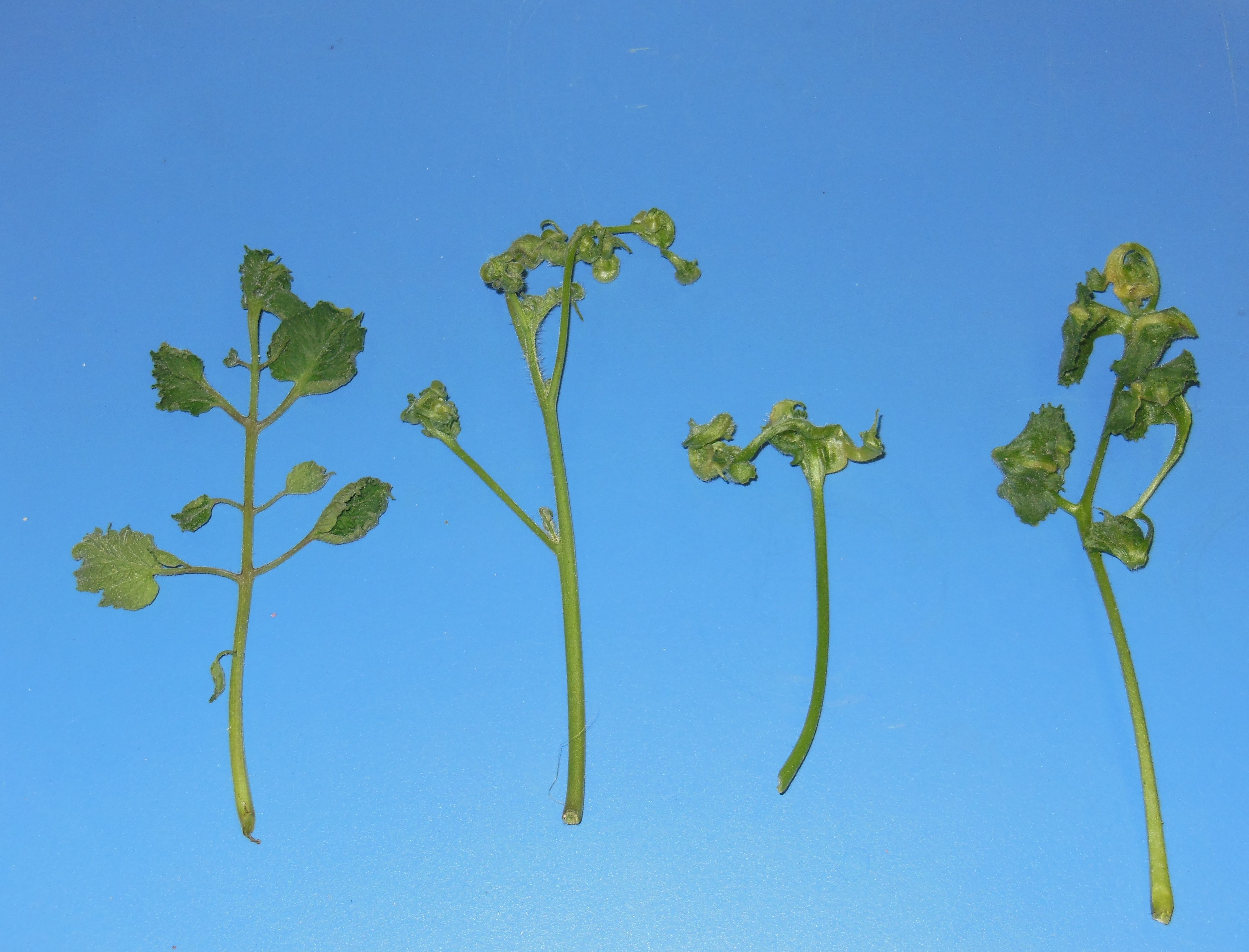
by Mark Tancig | May 24, 2016
Humans have used animal manures to fertilize food crops for thousands of years. Manures are an organic source of plant nutrients and are often a waste byproduct that must be properly managed when raising animals. Today, many farmers and backyard gardeners continue to use animal manures to provide nutrition to their crops. However, a recent experience at our local extension office brought to our attention the need to know what else, besides nutrients, is in the manure used.
A local backyard gardener brought in samples of tomato plants that had strange new growth. She had purchased the tomato plants, along with other vegetable plants, from a local nursery. When she repotted the tomato plants into larger pots, she added horse manure from her own horses to the soil mix. She then noticed this strange growth on the tomatoes, but not in the other vegetable plants that were repotted without adding horse manure. Herbicide damage was one of the first potential causes we suggested, since the new growth was twisted and distorted, a common symptom of plants that have been sprayed by herbicides. The gardener was sure she had not sprayed any herbicides near these plants, or in the pasture where she keeps her horses.
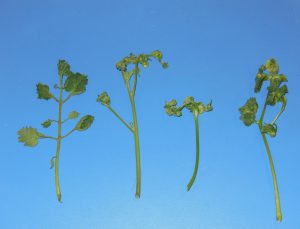
Herbicide damaged tomato plants. Photo by: Mark Tancig
Photos of the tomato plants were shared with other NW District agents and an agriculture agent with livestock and hay producer experience had the probable answer – herbicide damage due to the horses being fed hay from a hayfield that was treated with a particular herbicide. Interestingly, this agent also had experience with these symptoms after their neighbor had similar issues using manure to fertilize the garden.
Herbicides with the active ingredients picloram or aminopyralid are able to cause this kind of unexpected damage to many gardeners’ crops. Herbicides containing these active ingredients are used in hayfields to control broadleaf weeds. These herbicides are especially effective at controlling hard to manage weeds such as thistle, nightshade, and nettle. They also provide long-lasting weed control. Unfortunately, the persistence of these ingredients extends into the hay, and also persists in the manure and urine of animals who eat hay from treated fields. These ingredients pass through the animal unchanged and remain active as an herbicide. Since many vegetable crops are broadleaf plants, the herbicide’s ingredients cause injury.
So what can a farmer or backyard gardener do to prevent this problem? When purchasing hay for livestock, ask the seller if they know whether the hayfield has been treated with herbicides that contain either picloram or aminopyralid. Most herbicides are known by their common names, rather than their chemical name. If they give you a common name or brand name, the active ingredient can be obtained by contacting your local extension office. If the seller can’t tell you, then, as a precaution, do not use the manure to fertilize broadleaf vegetable crops. The same question should be asked if purchasing hay for mulch as well. Composting the manure or hay does not break down the active ingredient, and may even concentrate it.
While we continue to use animal manures to fertilize our crops as our ancestors did, it’s important to remember that many of the tools and products we use today are much more advanced. These advanced products require that we stay informed of all precautions, use them responsibly, and, in this case, inform end users of any precautions. Remember to always read and follow the label and ask questions. And if a science-based answer is what you’re looking for, your local extension office is a good place to go!
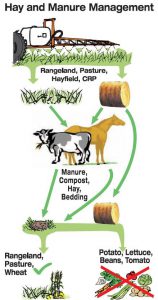
Warning from herbicide label.
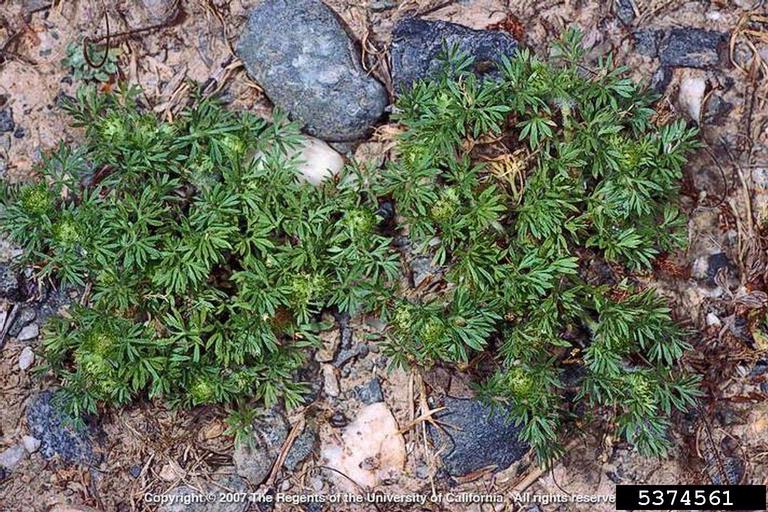
by Matthew Orwat | May 12, 2016
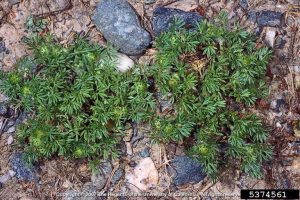
Burweed, Soliva Sessilis. – Image Credit: Joseph M. DiTomaso, University of California – Davis, Bugwood.org. Creative Commons License
This spring, lawn burweed has been an especially noticeable problem in lawns. Extension offices throughout Northwest Florida have been fielding many questions and finding solutions to lawn burweed infestations!
On the top of my list of lawn related annoyances is stepping into a patch of burweed, Soliva sessilis, which is in the sunflower family and is also known as spurweed. The leaves are opposite along the stem and sometimes resemble parsley. The main ways in which burweed can irk the casual gardener are sticking to socks, sneaking in with the dog, or littering flower beds with its nuisance. It can also hide in the house and reappear when shoes are removed. This causes pain in both the foot and the ear.
Aside from herbicides, maintaining a healthy vigorous lawn will prevent weeds from taking over. If your lawn is reasonably healthy and only a few instances of this weed exist, try to mechanically remove them and encourage the lawn to outgrow them.
If cultural methods aren’t sufficient, science has given us several options to control this irksome pest. Herbicides containing the active ingredients dicamba, 2,4-D or atrazine are good at controlling burweed as a post emergence control when applied from December through March. Be careful to use reduced rates on centipede and St. Augustine lawns, and never use more than the labeled rate since injury can occur when using these products on these species. Later applications have less effect on burweed because as it matures it is harder to control. Additionally the burs, once present on the lawn, are hard to remove. As the daytime temperatures rise to 90ºF, some of these herbicides may cause lawn damage. Try to keep the spray residue outside of the root zone of desirable plants to avoid injury and always follow label directions.
Be aware that burweed reproduces by seed, so mowing it down will only increase the problem by burying the seed for fall germination. Although we are now in the month of May, control of actively growing burweed might still be warranted if it is still flowering and setting seed. As temperatures warm up burweed will die, as it is a winter annual. In cases where it is already dying, control is not warranted since the natural cycle of winter annuals is concluding.
If an infestation of burweed has occurred this year, take note. The best time to apply pre-emergent herbicides to control burweed is in October. A widely used preemergence product for burweed control is isoxaben, which is sold under the brand name of Gallery as well as others. It prevents the weed from emerging from the ground when it germinates and can be used on St. Augustine, centipede, bahia and zoysia lawns, as well as in ornamental shrub beds. In northwest Florida, this herbicide needs to be applied in October for best results. A second application later in the season might be warranted. For more information about control, please consult this excellent article on lawn burweed management.
The active ingredients mentioned above are present in a variety of ‘trade name’ products* available from your local garden center, farm supply or co-op. Be sure to read label instructions carefully and contact your local extension office for any assistance. I hope all the northwest Florida lawn managers prevent burweed during the upcoming fall so that lawns will be burweed free next spring.
Happy Gardening!
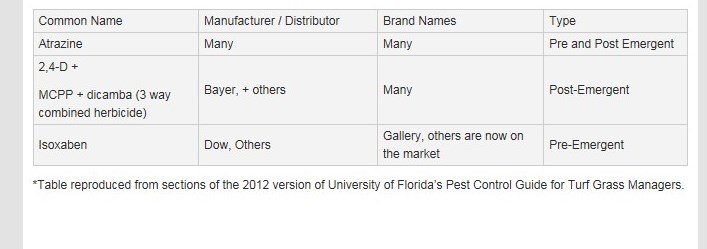
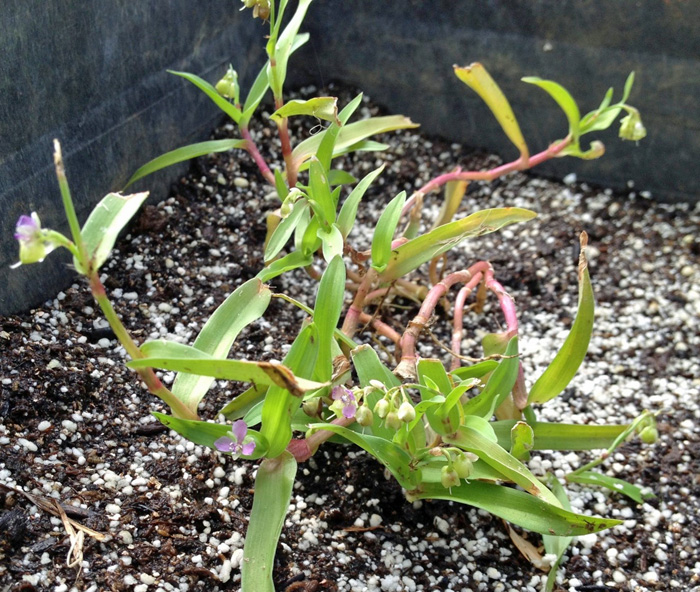
by Carrie Stevenson | Dec 4, 2015
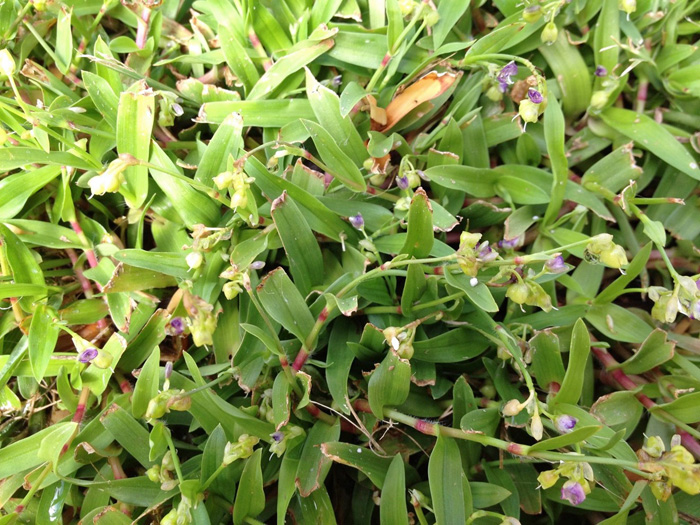
______________________Figure 1. Doveweed patch in St. Augustinegrass sod.__________________________
Ramon Leon, WFREC Weed Specialist
Doveweed (Murdannia nudiflora) is a summer annual weed species that belongs to the dayflower family. Over the last three years, this weed has become an important weed problem in residential lawns and sod production.
This weed has two key characteristics that make it successful. First, its seeds germinate late during the spring when soil temperatures reach 65-70°F. This represents a problem because at this time the effect of preemergence (PRE) herbicides applied in February or March might be too low to provide good doveweed control. Second, the leaves of this weed can be confused with St. Augustinegrass and centipedegrass leaves, and many people do not notice doveweed until the plants are large and are displacing the turf. Doveweed leaves are thick with a shiny rubbery texture. The plant produces creeping stems (stolons), and mowers can break these stolons spreading this weed across the field.
It is very important to keep in mind that doveweed prefers wet areas, so drainage issues or over-watering will favor the establishment and growth of this weed. For this reason, ensuring irrigation is not excessive is a key management practice to control this problem. Another cultural practice that plays a major role on doveweed management is mowing. Mowing too short and too frequently will favor doveweed because its leaves will grow horizontally avoiding the mower blades. Chose a mowing height that allows good ground cover , yet only removes a third of the turf leaf blades.

___________Figure 2. Individual doveweed plant showing flowers, fruits, and stolons with root in nodes.________
Control
Doveweed is easier to control before emergence than when plants are well established. Atrazine is one of the most effective herbicides to control doveweed. A maximum rate of 1 lb. of active ingredient (ai) per acre (A) and no more than 2 lb. ai per year are recommended to achieve both adequate control and avoid turfgrass injury. Atrazine should be applied right before or soon after doveweed emerges to maximize control.
For PRE control, S-metolachlor (Pennant Magnum™), dimethenamid-P (Tower™), and indaziflam (Specticle™) are herbicides that can considerably reduce doveweed establishment, especially if the application is done closer to doveweed emergence timing. These herbicides also provide good control of other important weed species such as crabgrass and goosegrass, which emerge earlier in the spring. In order to control early emerging weeds and doveweed, split applications are preferred. For example, the first application is done at the end of February or early March and the second one 4 to 6 weeks after. In this way, we can extend PRE control until doveweed starts emerging.
If we observe doveweed emerging after PRE applications, we have several postemergence (POST) herbicides that will provide control, as long as the plants are less than 2 inches in size and have not produced stolons. Products containing 2,4-D and dicamba can provide fair control of doveweed. However, repeated applications or applications in combination with other herbicides will be required for adequate control. There are commercial products with formulations that combine 2,4-D or dicamba with other herbicides such as mecoprop-p, carfentrazone (Quicksilver™), thiencarbazone and iodosulfuron (e.g., Celsius™, Tribute Total™). This type of three− or four−way combination can provide enhanced doveweed control. If doveweed has fully displaced the turf in spots, it is probably easier and more effective to kill doveweed with a directed application of glyphosate (RoundUp™) and re-seed or re-sod the area.
Because doveweed seeds can live for several years in the soil, it will take two to three years of continuoous control to eliminate doveweed populations. Although herbicides are useful tools to control doveweed, the most important factor to prevent doveweed problems is to have vigorous healthy turf. Doveweed requires a lot of sunlight, so if the turf effectively shades the ground, doveweed will have a hard time growing and producing new seed.
For more information on managing turf weeds download:
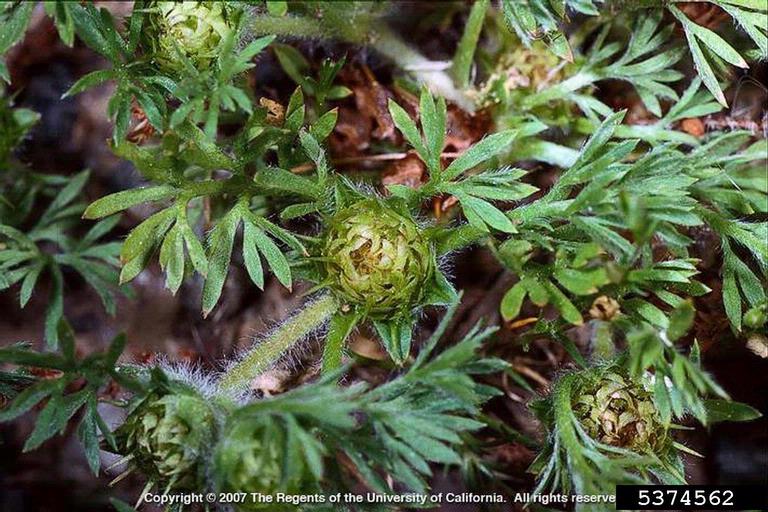
by Matthew Orwat | Oct 6, 2015
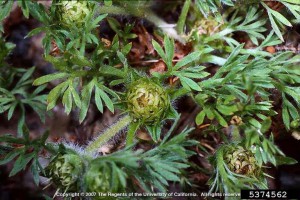
Lawn Burweed, Soliva Sessilis, Closeup – Image Credit: Joseph M. DiTomaso, University of California – Davis, Bugwood.org, Create Commons License
On this bright and sunny early fall morning I was thinking about all of the great gardening opportunities the cooler fall weather is bringing us in the Florida Panhandle. However, my thoughts drifted to the annoyances that the gardeners find when trying to enjoy their lawn or garden.
On the top of my list is stepping into a patch of burweed, which is in the sunflower family and is also known as spurweed. The leaves are opposite along the stem and sometimes resemble parsley. The main ways which burweed can irk the casual gardener are sticking to socks, sneaking in with the dog, or littering flower beds with its nuisance. It can also hide in the house and reappear when shoes are removed. This causes pain in both the foot and the ear.
Aside from herbicides, maintaining a healthy vigorous lawn will prevent weeds from taking over. If you lawn is reasonably healthy and only a few instances of this weed exist, try to mechanically remove them and encourage the lawn to outgrow them.
If cultural methods aren’t sufficient, science has given us several options to control this irksome pest. A widely used pre-emergence product for burweed control is isoxaben, which is sold under the brand name of Gallery as well as others. It prevents the weed from emerging from the ground when it germinates and can be used on St. augustine, centipede, bahia and zoysia lawns, as well as ornamental shrub beds. In northwest Florida, this herbicide needs to be applied in October for best results.

Burweed, Soliva Sessilis. – Image Credit: Joseph M. DiTomaso, University of California – Davis, Bugwood.org. Creative Commons License
Herbicides which contain the active ingredients dicamba, 2,4-D or atrazine are good at controlling burweed as a post emergence control when applied from December through early March. Be careful to use reduced rates on centipede and St. augustine lawns, and never use more than the labeled rate. Later applications have less effect on burweed because as it matures it is harder to control. Additionally the burs, once present on the lawn, are hard to remove. As the daytime temperatures get a few degrees over 80, some of these herbicides may cause lawn damage so immediate application is advised. Try to keep the spray residue outside of the root zone of desirable plants to avoid injury and always follow label directions. Be aware that burweed reproduces by seed, so mowing it down will only increase the problem by burying the seed for fall germination.
The active ingredients mentioned above are present in a variety of ‘trade name’ products* available from your local garden center, farm supply or CO-OP. I hope all the northwest Florida lawns prevent burweed so that the spring lawns will be burweed free. Happy Gardening!
| Common Name |
Manufacturer / Distributor |
Brand Names |
Type |
| Atrazine |
Many |
Many |
Pre and Post Emergent |
| 2,4-D +
MCPP + dicamba (3 way combined herbicide) |
Bayer, + others |
Many |
Post-Emergent |
| Isoxaben |
Dow, Others |
Gallery, others are now on the market |
Pre-Emergent |
*Table reproduced from sections of the 2012 version of University of Florida’s Pest Control Guide for Turf Grass Managers.
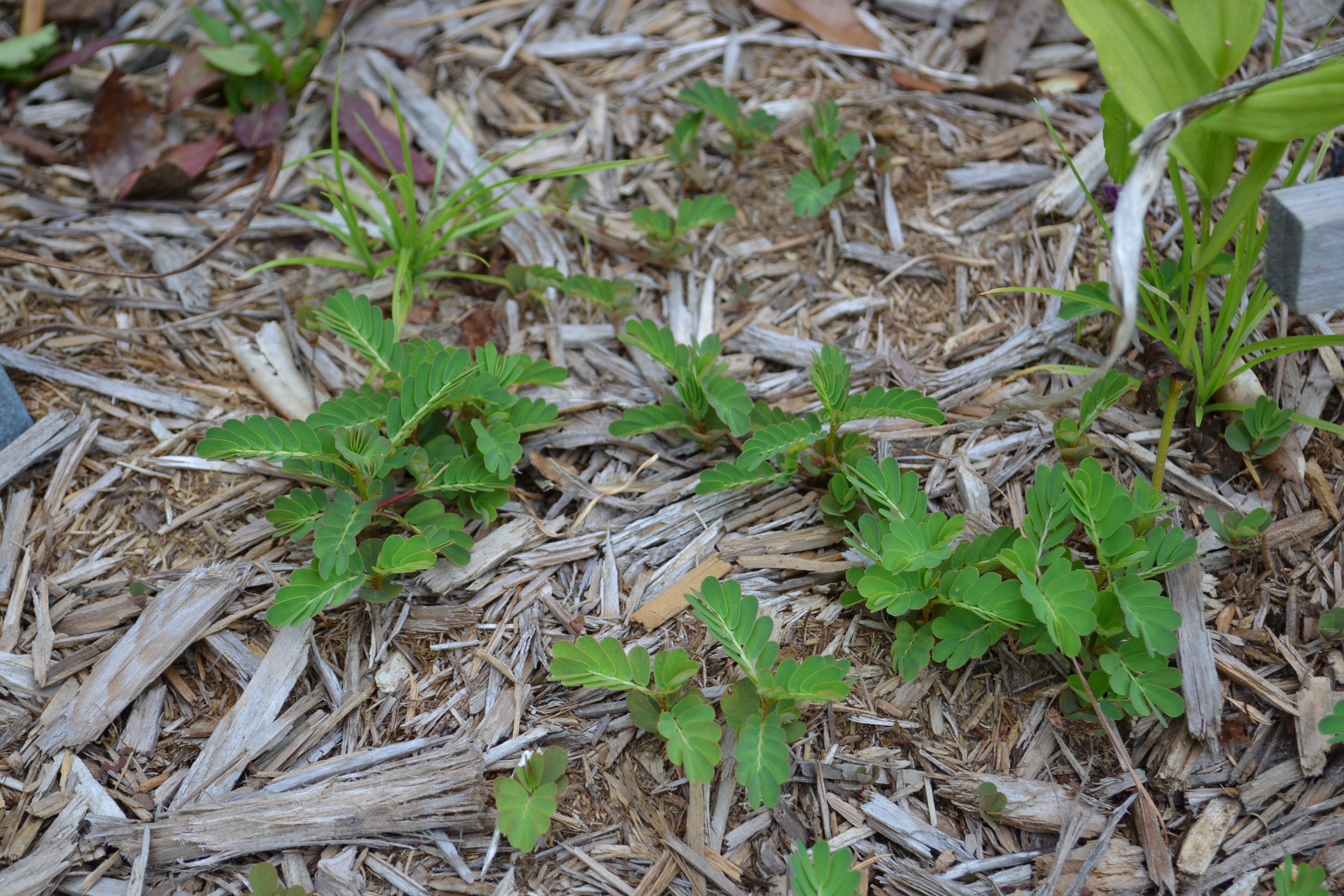
by Beth Bolles | Sep 16, 2015
Just when you think your battle against weeds is over for the summer, cooler nighttime temperatures and shorter days spark the beginning of a new crop of your least favorite plants. The question of many homeowners is: how did all the weeds get into my landscape?
There are many ways that weeds make it to the landscape. They can be brought in with new soil, mulch, container plants, dropped by birds, delivered on the fur of animals, carried by wind, or on the deck of a lawn mower. If that is not enough to depress you, then also realize that regardless of outside sources of weeds, your landscape already has plenty onsite that you don’t even know about.
In the soil, there is a large number of weed seeds ready to germinate when the conditions are just right. Understanding how your common landscape practices can encourage or discourage the germination of these seeds, can help you begin to manage some weed infestations.
Many of the seeds of common annual weeds are very small. They require exposure to sunlight in addition to the proper temperatures and moisture to germinate. Sunlight is critical, though, and seeds will not germinate without adequate sunlight. If the small seeds are deep in the soil, you will probably never know they are there. When you turn soil or disturb soil such as when installing plants, you bring the small seeds close to the surface and closer to light. They can then be stimulated to germinate. The next thing you know, you have an area covered in weed seedlings.
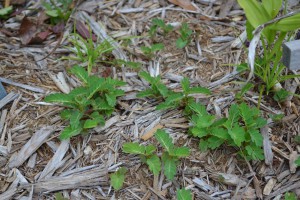
As mulch thins, small seeds of weeds are stimulated by sunlight to begin growing.
What does this mean for your gardening practices? Try your best to block sunlight from hitting exposed soil. You can do this by keeping a healthy turf, free of thinning spaces. A 2 to 3 inch layer of mulch in plant beds and vegetable gardens will reduce weed seed germination. Finally, when you are installing plants in an established bed, try not to mix soil with surrounding mulch. Seeds will easily germinate within the mulch if it becomes mixed with soil.
It is inevitable that your landscape will have some weeds but a few easy gardening practices can reduce some of your weed frustrations.
For more information:
Gardening Solutions: Weeds and Invasive Plants
Improving Weed Control in Landscape Planting Beds
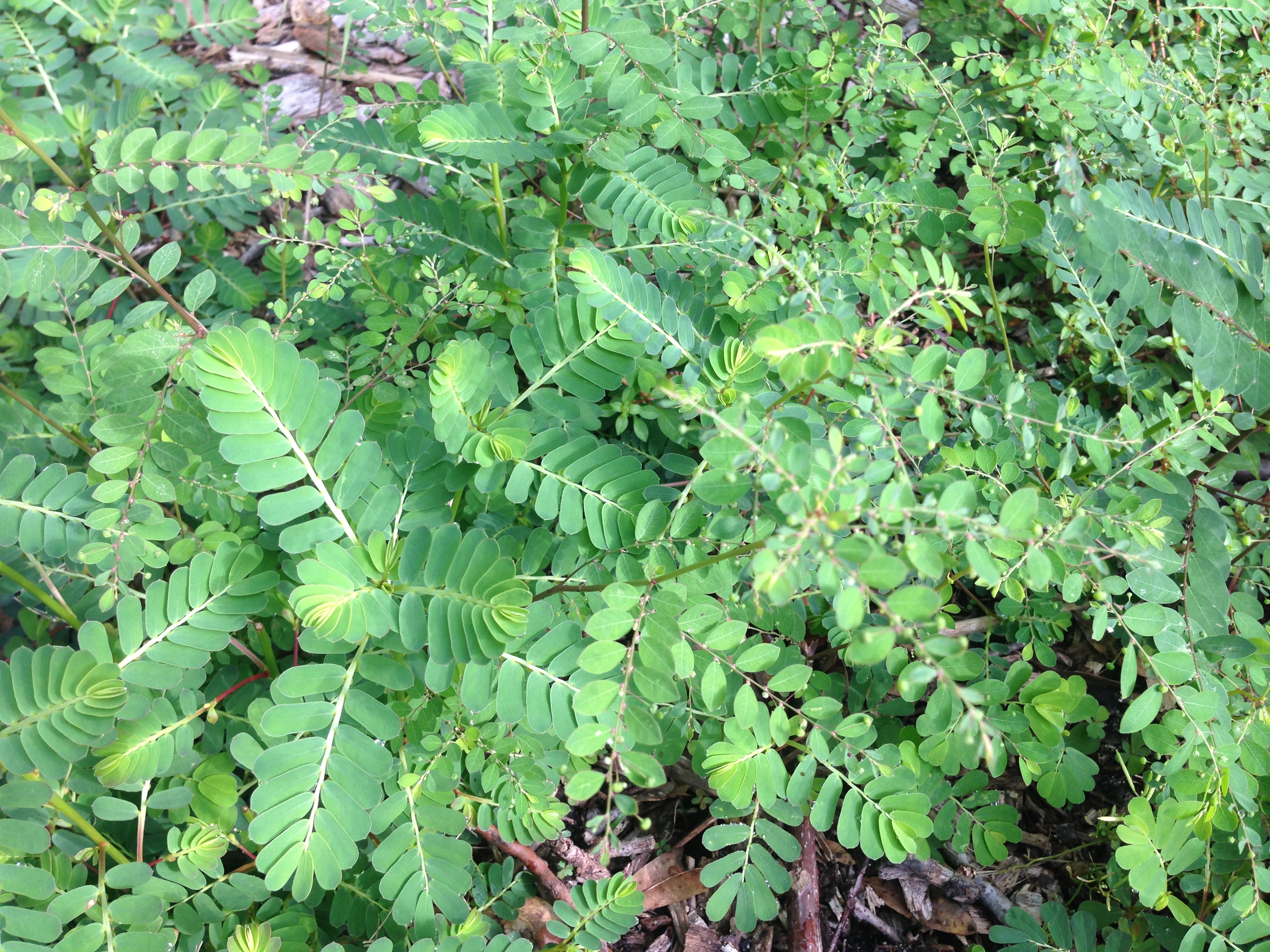
by Les Harrison | Aug 11, 2015
Weeds are growing everywhere, especially in manicured lawns and landscapes despite the best efforts of owners who have spared no expense to remove the offending flora. Herbicides to control the weeds seem to be less effective as August progresses.
The reality, at least about the herbicides, is different from perceived appearances. Herbicides can be a wonderful tool for the homeowner, if applied properly.
[important]The first point to remember about herbicides is to always, Always, ALWAYS apply them as instructed by the label directions. The oft quoted mantra of “the label is the law” is accurate.[/important]
Herbicides and their labeling are periodically reviewed and assessed to confirm effectiveness against target weeds without damaging the environment. Not following the label directions can have many negative implications for both the environment and the applicator.
Herbicides are either selective or non-selective when killing plants. Non-selective herbicides kill or damage every plant, but selective herbicides target a narrower range of plants.
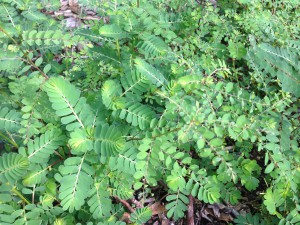
Chamberbitter, a common annual weed. Photo credit: Mary Derrick, UF/IFAS Extension.
Never apply herbicides when there is a breeze or wind. Herbicide drift can injure or destroy plants that are not the intended target.
High temperatures can contribute to the drift problem by volatizing some of the herbicide spray. Even the lightest air movement will cause drift off the target weeds when this condition exists. Herbicide drift can also be deposited in ponds and streams, harming the aquatic creatures that live there. Some herbicides are toxic to fish, insects and other animals that can be killed by tiny amounts of the active chemical. Additionally, the off target herbicides can kill aquatic plants. When the dead plants decay, they deplete the water of oxygen, again threatening or ending the life of the water’s residents.
Rain or dew resulting from high humidity can negate a herbicide’s application. If a leaf is wet, most or all the herbicide will run off on to the soil where it can leach into the water table.
Unless stated on the label, herbicides work only when the plant is actively growing. A hot, dry week or two can put a plant in drought mode, suspending growth and the herbicide’s effectiveness.
Many weeds have already produced seeds for next spring. Herbicides applied now will not affect the germination of that seed months from now.
The most effective strategy is to mow weeds before they set seed or to collect and destroy those which have already produced seed. Even with 100 percent success at eliminating this year’s weed seed crop, there will be weeds next year.
Some weed seed remain in the soil, sometimes for decades, only to germinate when conditions are perfect for their sprouting. Sickle pod and crotalaria are local examples of long term seed vigor.
Other seed can blow in or be dropped by wild or domestic animals passing through the property. A pre-emergent herbicide which stops germination can help control these latent invaders.
For more information:
Weed Management Guide for Florida Lawns
Gardening Solutions: Weeds















